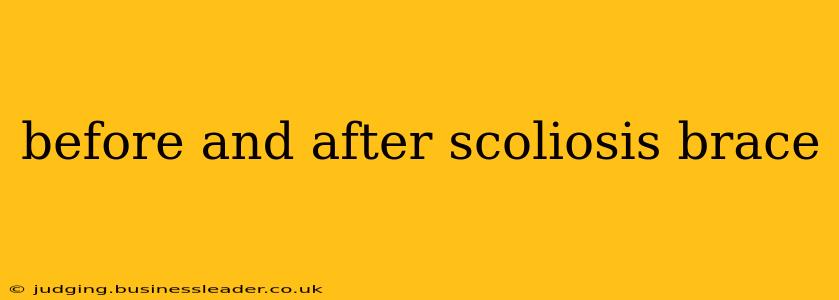Scoliosis, a sideways curvature of the spine, can significantly impact a person's posture, health, and confidence. For many, bracing is a crucial part of treatment, aiming to prevent further curvature progression and improve spinal alignment. Understanding the changes that occur before and after bracing is essential for both patients and their families. This guide explores the typical before-and-after experiences, addressing common questions and concerns.
What Does Scoliosis Look Like Before Bracing?
Before bracing, the visual signs of scoliosis vary depending on the severity of the curvature. In mild cases, the curvature may be barely noticeable, perhaps only detectable through a physical examination. However, as the curve progresses, the following may become apparent:
- Uneven shoulders: One shoulder may appear higher than the other.
- Uneven hips: One hip may be higher or more prominent than the other.
- Prominent rib cage: One side of the rib cage may protrude more than the other, creating an uneven appearance.
- Visible spinal curvature: A noticeable curve in the spine may be visible when the person bends forward.
- Postural changes: The individual might develop a forward head posture or a noticeable lean to one side to compensate for the curvature.
- Back pain or discomfort: This is a common symptom, especially as the scoliosis worsens.
The severity of these visual signs and symptoms will help determine the need for and type of scoliosis brace.
What Happens During the Bracing Process?
The process begins with a thorough diagnosis by an orthopedist or scoliosis specialist. This usually involves a physical exam, X-rays to measure the curve, and potentially other imaging techniques. Once the severity of the scoliosis is determined, the doctor will discuss treatment options, including bracing.
The type of brace prescribed will depend on various factors, including the age of the patient, the location and severity of the curvature, and the patient's skeletal maturity. Common types include Boston braces, Milwaukee braces, and thoracolumbosacral orthoses (TLSO).
The brace is custom-made to fit the patient's body precisely, usually requiring multiple fittings. Patients will be instructed on how to properly wear and care for the brace.
How Does a Scoliosis Brace Affect the Body?
The primary goal of a scoliosis brace is to prevent the progression of the spinal curvature. It does this by applying pressure to the convex side of the curve, gently counteracting the sideways bending. The brace helps maintain the spine in a more neutral position, promoting healthy growth and development.
The brace doesn't "cure" scoliosis, but it significantly reduces the likelihood of the curve worsening, potentially avoiding the need for surgery in the future.
What Does Scoliosis Look Like After Bracing?
The changes observed after consistent bracing will depend on factors such as the severity of the initial curvature, the patient's compliance with wearing the brace, and their skeletal maturity. However, generally, improvements may include:
- Improved posture: The shoulders and hips will appear more level.
- Less prominent rib cage: The asymmetry of the rib cage will be reduced.
- Reduced spinal curvature: The visible curve in the spine will be less pronounced.
- Reduced pain: Many patients experience a reduction in back pain and discomfort.
- Increased confidence: The improved posture and reduced physical discomfort often lead to a boost in self-esteem.
It's important to remember that the results vary from person to person. Some individuals may see more dramatic improvements than others.
What are the Potential Side Effects of Scoliosis Bracing?
While bracing offers many benefits, it's crucial to be aware of potential side effects:
- Skin irritation: The brace can cause skin irritation or chafing, particularly in areas where the brace makes contact with the skin.
- Discomfort: The brace can initially feel uncomfortable or restrictive.
- Body image issues: Some patients may feel self-conscious about wearing a brace.
- Limited activity: The brace may restrict certain activities, although appropriate modifications can allow participation in many activities.
These side effects are generally manageable with proper brace fitting, skin care, and ongoing communication with the medical team.
How Long Do I Have to Wear a Scoliosis Brace?
The duration of brace wear varies widely and depends on factors like the patient’s age, skeletal maturity, and the severity of the curve. It’s typically prescribed for several years, often worn 23 hours a day. The orthopedic doctor will make recommendations and monitor progress regularly, adjusting the treatment plan as needed. A child might wear a brace until their bones mature and stop growing.
Can I Do Anything to Help While Wearing a Brace?
While wearing the brace is the primary treatment, maintaining a healthy lifestyle can support the effectiveness of the brace:
- Physical therapy: Regular physical therapy exercises strengthen the muscles that support the spine, further improving posture and reducing pain.
- Healthy diet: Proper nutrition helps ensure optimal bone health and growth.
- Regular check-ups: Follow-up appointments with the doctor are essential to monitor progress and make necessary adjustments.
Conclusion
The before-and-after experience with a scoliosis brace can be transformative. While the brace itself doesn't "fix" scoliosis, it plays a vital role in preventing further progression and improving posture and well-being. Consistent use, combined with a healthy lifestyle and regular medical supervision, is key to achieving optimal results. Open communication with your healthcare provider is crucial throughout the process.
